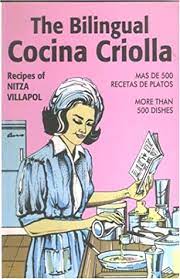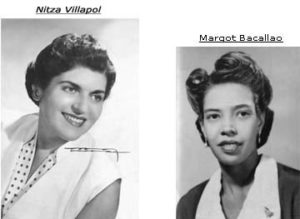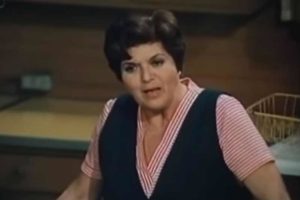NITZA VILLAPOL Y SU “COCINA AL MINUTO” POR MAS DE CUATRO DECADAS EN LAS PANTALLAS CUBANAS. PHOTOS/VIDEOS.

Nitza Villapol fue una “chef”, escritora de libros de cocina y presentadora de la televisión en Cuba. Nitza nació en Nueva York, en 1923. Diez años más tarde se radicó en la Habana con su familia, y allí hizo estudios hasta diplomarse como Doctora en Pedagogía, en 1948. En su acercamiento a la cocina hubo mucho de vocación y un poco de casualidad. Gustó siempre de compilar recetas y un día consideró que resultaría útil publicarlas. Su facilidad expositiva, su carisma y su capacidad para comunicarse, la harían sobresalir pronto entre las que realizaban la misma tarea –Ana Dolores Gómez, Nena Cuenco de Prieto, Carmencita San Miguel, María Radelat de Fontanills y María Antonieta de la Reyes Gavilán entre otras.
En la década de 1950, Villapol era famosa en Cuba por sus libros de cocina estándar sobre cocina cubana, Cocina criolla (1954) y Cocina al minuto (1958). De 1951 a 1997 tuvo su propio programa de cocina en la televisión cubana, uno de los más longevos de la historia de la televisión.
Después de 1959, se puso del lado de la revolución y durante el “Período Especial” de Cuba de principios de la década de 1990, logró demostrar en su programa cómo preparar recetas tradicionales cubanas en las difíciles circunstancias de racionamiento, pobreza y escasez.
Villapol encontró un acomodo con el comunismo cubano y logró conquistar a su audiencia cocinando dentro de las limitaciones reales del socialismo existente.
 VIDEOS- Nitza Villapol en la Cocina de la TV…
VIDEOS- Nitza Villapol en la Cocina de la TV…
NITZA Y SU COCINA AL MINUTO
Sus programas de radio y televisión la hicieron enormemente popular. Sus libros batieron siempre récords de venta y sus colaboraciones en la prensa escrita eran buscadas y conservadas por una infinidad de lectoras –y lectores. Pocos autores abordaron el tema de la cocina cubana con tanta extensión y profundidad como Nitza Villapol. Junto a ella se distinguió su ayudante Margot Bacallao que la acompaño durante muchos años en la composición de sus creaciones culinarias.
Su labor fue más allá de la simple recopilación y divulgación de recetas, con todo lo importante que eso pueda ser. La autora de Cocina al minuto, su libro más emblemático y difundido, enfrentó la cocina también como un problema económico y dietético que forma parte de la cultura y la nacionalidad, y lo hizo con un rigor no exento de vuelo artístico. “La cocina –aseguraba- es un arte, un arte de cada pueblo, un arte menor que forma parte de la cultura de los pueblos”.
Se dice que su programa televisivo, por las más de cuatro décadas que se mantuvo en pantalla, podría haber sido asentado en el Libro de Guinness. En un tiempo solo lo superaba, en antigüedad, Meet the Press, de la televisora norteamericana NBC. Pero si este lo aventajaba en cuatro años, Nitza, como conductora, no tuvo rivales: nadie permaneció más tiempo que ella al frente de un espacio de TV. Su contendiente más cercano sería el periodista Lawrence E. Spivak, que llevó veinte y siete años como panelista o conductor del espacio mencionado. Nitza lo hizo durante cuarenta y cuatro años.
Tan larga presencia en la pequeña pantalla impuso la imagen de una mujer simpática, meticulosa, convincente y dotada de un enorme poder de comunicación. El carisma era, sin embargo, solo una de las aristas de Nitza Villapol. Detrás de su aparente desenfado, animaba una mujer de cultura y arduos estudios. Lo demostró cuando la UNESCO le confió la encomienda de escribir el capítulo relativo a la cocina en el libro África en América, que se publicaría en varios idiomas y tiene ya diez ediciones.
 VIDEOS- Nitza Villapol y Margot Bacallao en Cocina…
VIDEOS- Nitza Villapol y Margot Bacallao en Cocina…
NITZA VILLAPOL EN LA CULTURA MENOR CUBANA, LA COCINA.
“Culta, inteligente, dotada de una rara capacidad de persuasión y profunda conocedora de tan complejas ramas como la nutrición y la dietética, Nitza Villapol es, sin lugar a dudas, la personalidad que más ha influido en el dinamismo y actualización de la cocina cubana, y, sobre todo, en la dificilísima tarea de modificar los hábitos alimentarios del país”, decía en 1986, el escritor Jaime Sarusky en su “Encuentro con la cocina cubana”.
Porque a Nitza le tocó acometer parte de su trabajo en épocas de grandes carencias: primero, cuando a consecuencia del bloqueo norteamericano a la Isla, el cubano se vio privado de productos y condimentos tradicionales en su cocina. Luego, cuando el derrumbe del campo socialista, cortó el suministro de renglones alimentarios que ya se habían hecho habituales en la mesa cubana.
Recordaba Sarusky en su artículo citado que Nitza, en los años 60, enseñó a preparar y a degustar platos como la merluza y la tilapia, desconocidos en la dieta del cubano promedio, lo convenció de las ventajas de cocinar con menos grasa, le reveló el secreto para prescindir de los huevos en la elaboración de un pudín y le dijo cómo empanar la carne con agua y harina como únicos ingredientes. ¿Qué escaseaba la harina para las frituras? Nitza entonces ponía la solución al alcance de la mano: bastaba, para que apareciera, con derretir un paquete de macarrones.

Es por eso que, en opinión de Sarusky, son pocos los que dudan en Cuba que con la magia y los descubrimientos culinarios de esta mujer podría llenarse un delicioso tratado sobre la infinita e inagotable inventiva de los cubanos. Pero Nitza restó siempre importancia al asunto, y en una ocasión confesó: “Sencillamente, invertí los términos. En lugar de preguntarme cuáles ingredientes hacían falta para hacer tal o cual receta, empecé por preguntarme cuáles eran las recetas realizables con los productos disponibles”.
Al desencadenarse en Cuba la crisis económica de los 90, el tema de la cocina se hizo tabú en la Isla, y el programa de Nitza Villapol desapareció del aire de la noche a la mañana. Fue un error, diría más tarde José Luis Santana, presidente entonces de la Federación Culinaria Cubana. “Desde que desapareció el programa Cocina al minuto se ha seguido cierta política errónea de no tocar el tema de la alimentación en los medios. Nuestros hogares se han visto privados de un asesoramiento, de una ayuda, y eso debía rescatarse también”, expresó el chef Santana a la prensa en 1996.
Felizmente, así fue. Pero ya Nitza se había deteriorado mucho para reaparecer en pantalla. Aun así, escribió y publicó nuevos títulos, y se vendieron con el éxito de siempre. La gente, sin embargo, la fue olvidando. Cuando murió, en 1998, solo un puñado de personas acompañó hasta la tumba a la que fue una de las mujeres más populares de Cuba.
ALGUNOS EJEMPLOS DE SUS “CREACIONES”..
Hizo un aporte decisivo al estudio de la culinaria cuando concluyó que la cocina comenzó a ser cubana cuando los garbanzos se suprimieron del ajiaco. Hasta entonces, ese sopón, que se nutre de muy variadas carnes secas y frescas, no había sido más que el encuentro del cocido español con las viandas de la Isla.
La diferencia se acentuó, sentenciaba Nitza, cuando el criado doméstico –negro o chino- asumió la cocina de los blancos. Por la vía de la esclavitud, precisamente, y de la industria azucarera, se imponen en el paladar cubano toda una serie de alimentos y condimentos y entran hábitos dietéticos que llegan hasta hoy.

La degustación del arroz en las dos comidas diarias como cereal básico, la presencia de un guiso que “moje” ese arroz, el gusto por lo frito y la preferencia por lo dulce, son constantes en el paladar criollo, aseguró, y afirmó, además, que la gente se ata más a la forma de elaborar un alimento que al alimento mismo.
Uno de los aspectos más lentos y difíciles de modificar en cualquier cultura son los hábitos de conducta entre los cuales se encuentran los alimentarios. Para que esa modificación sea verdadera, profunda y duradera, debe partir del conocimiento de algunos de los factores que conforman esos hábitos y cuáles son las modificaciones que pueden hacerse en aras de una mejor salud”, afirmaba Nitza Villapol.
Ella lo supo muy bien e hizo su legado en más de quince títulos, miles de programas radiales y televisivos e infinidad de columnas de prensa, como la que durante años mantuvo en la revista Cuba Internacional que la tuvo hasta el final entre sus colaboradores más distinguidos. Ahora que ya no está habrá que remitirse una y otra vez a ese legado para seguir gozando de las delicias de la buena mesa y del arte y la gracia que Nitza Villapol supo imprimirles.

RECOMIENDENOS A SUS AMISTADES * PREFIERA A NUESTROS SPONSORS.

NITZA VILLAPOL AND HER “COCINA AL MINUTO” FOR MORE THAN FOUR DECADES ON CUBAN SCREENS

Nitza Villapol was a “chef”, cookbook writer, and television presenter in Cuba. Nitza was born in New York in 1923. Nitza was born in New York in 1923. Ten years later she settled in Havana with her family and studied here until graduating as a Doctor of Pedagogy in 1948. In her approach to cooking, there was a lot of vocation and a little casually. She always liked to compile recipes and one day she thought it would be useful to publish them. Her expository ease, her charisma and her ability to communicate would soon make her stand out among those who performed the same task –Ana Dolores Gómez, Nena Cuenco de Prieto, Carmencita San Miguel, María Radelat de Fontanills and María Antonieta de la Reyes Gavilán among others.
By the 1950s, Villapol was famous in Cuba for her standard cookbooks on Cuban cuisine, Cocina Criolla (1954) and Cocina al minute (1958). From 1951 to 1997 she had her own cooking show on Cuban television, one of the longest-running in television history.
After 1959, she sided with the revolution and during Cuba’s “Special Period” of the early 1990s, she managed to demonstrate on her show how to prepare traditional Cuban recipes under the difficult circumstances of rationing, poverty, and scarcity. Villapol found accommodation with Cuban communism and managed to win over her audience by cooking within the real limitations of existing socialism.
NITZA AND ITS KITCHEN TO THE MINUTE
Her radio and television shows made her enormously popular. Her books always broke sales records and her collaborations in the written press were sought after and preserved by an infinity of readers –and readers. Few authors have addressed the subject of Cuban cuisine with such length and depth as Nitza Villapol. Along with her, her assistant Margot Bacallao stood out, accompanying her for many years in the composition of her culinary creations.

Her work went beyond the simple compilation and dissemination of recipes, as important as that may be. The author of Kitchen to the Minute, her most emblematic and widespread book, also faced cooking as an economic and dietary problem that is part of culture and nationality, and she did so with a rigor not exempt from artistic flair. “Cooking -she assured- is an art, an art of each town, a minor art that is part of the culture of the towns”.
It is said that her television program, for the more than four decades, that it remained on screen, could have been settled in the Guinness Book. At one time she was only surpassed in seniority by NBC’s Meet the Press. But if he surpassed him by four years, Nitza, as a host, had no rivals: no one stayed longer than her in front of TV space. Her closest contender would be the journalist Lawrence E. Spivak, who spent twenty-seven years as a panelist or host of the aforementioned space. Nitza did it for forty-four years.
Such a long presence on the small screen imposed the image of a nice, meticulous, convincing woman endowed with an enormous power of communication. Her charisma was, however, only one of Nitza Villapol’s edges. Behind her apparent nonchalance, she encouraged a woman of culture and hard studies. She demonstrated this when UNESCO entrusted her with the task of writing the chapter on cooking in the book Africa in America, which would be published in several languages and now has ten editions.
NITZA VILLAPOL IN THE MINOR CUBAN CULTURE, THE KITCHEN.
“Cultured, intelligent, endowed with a rare capacity for persuasion and profound knowledge of such complex branches as nutrition and dietetics, Nitza Villapol is, without a doubt, the personality that has most influenced the dynamism and updating of Cuban cuisine. , and, above all, in the very difficult task of changing the country’s eating habits”, said the writer Jaime Sarusky in 1986 in his “Encounter with Cuban cuisine”.
Because Nitza had to undertake part of her work in times of great shortages: first when as a result of the US blockade of the Island, Cubans were deprived of traditional products and condiments in her kitchen. Later, when the collapse of the socialist camp, she cut off the supply of food items that had already become commonplace on the Cuban table.

Sarusky recalled in his cited article that Nitza, in the 1960s, taught how to prepare and taste dishes such as hake and tilapia, unknown in the diet of the average Cuban, convinced him of the advantages of cooking with less fat, revealed the secret to dispense with the eggs in the preparation of a pudding and told him how to bread the meat with water and flour as the only ingredients. What was the shortage of flour for frying? Nitza then put the solution within reach of her hand: it was enough, for it to appear, with melting a package of macaroni.
That is why, in Sarusky’s opinion, there are few in Cuba who doubt that with the magic and culinary discoveries of this woman a delicious treatise on the infinite and inexhaustible inventiveness of Cubans could be filled. But Nitza always downplayed the matter, and on one occasion she confessed: “I simply inverted the terms. Instead of asking myself what ingredients were needed to make this or that recipe, I started by asking myself what recipes could be made with the available products”.
When the economic crisis of the 1990s broke out in Cuba, the subject of cooking became taboo on the island, and Nitza Villapol’s program disappeared from the air overnight. It was a mistake, José Luis Santana, then president of the Cuban Culinary Federation would say later. “Since the program Kitchen at the Minute disappeared, a certain erroneous policy of not touching on the subject of food in the media has been followed. Our homes have been deprived of advice, of help, and that had to be rescued as well,” chef Santana told the press in 1996.
Happily, it was. But Nitza had already deteriorated too much to reappear on the screen. Still, she wrote and published new titles, and they sold as well as ever. People, however, were forgetting her. When she died, in 1998, only a handful of people accompanied her to the grave where she was one of the most popular women in Cuba.
SOME EXAMPLES OF HER “CREATIONS”…
She made a decisive contribution to the study of cuisine when she concluded that the kitchen began to be Cuban when chickpeas were removed from the ajiaco. Until then, this sopon, which is nourished by a wide variety of dry and fresh meats, had been nothing more than the meeting of the Spanish stew with the viands of the Island.

The difference was accentuated, Nitza sentenced when the domestic servant – black or Chinese – took over the kitchen of the whites. By way of slavery, precisely, and the sugar industry, a whole series of foods and condiments are imposed on the Cuban palate and dietary habits enter that continues to this day.
The taste of rice in the two daily meals as a basic cereal, the presence of a stew that “wets” that rice, the taste for fried food, and the preference for sweetness, are constants in the Creole palate, he assured, and he also affirmed, that people are more attached to the way of preparing food than to the food itself.
One of the slowest and most difficult aspects to modify in any culture are behavioral habits, among which are eating habits. For this modification to be true, deep, and lasting, it must start from the knowledge of some of the factors that make up these habits and what are the modifications that can be made for the sake of better health”, stated Nitza Villapol.
She knew it very well and made her legacy in more than fifteen titles, thousands of radio and television programs, and countless press columns, such as the one she maintained for years in the magazine Cuba Internacional, which had her among its most distinguished collaborators until the end. . Now that she is gone, we will have to refer again and again to that legacy of hers to continue enjoying the delights of good food and the art and grace that Nitza Villapol knew how to imprint on them.
Agencies/ Wiki/ Ciro Bianchi/ NitzaVillapolBio./ Extractos/ Excerpts/ Internet Photos/ YouTube/ Arnoldo Varona/ www.TheCubanHistory.com
THE CUBAN HISTORY, HOLLYWOOD.

RECOMIENDENOS A SUS AMISTADES * PREFIERA A NUESTROS SPONSORS.




























